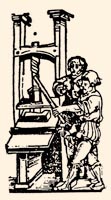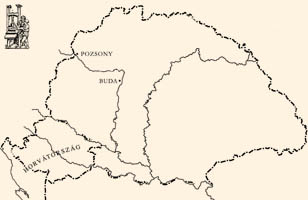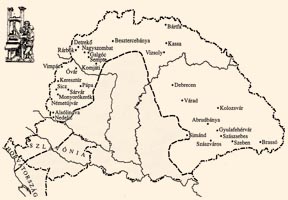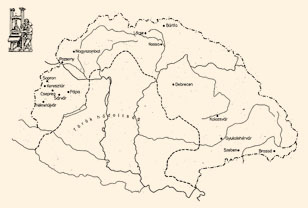The first three centuries (1473–1635)
 Printing in Hungary in the hand-press period is introduced in a way that the brief illustrated description of the history and activities of typographies is associated with the 15th and 16th century sections of the "Clavis" database, which comprises Hungarian presses, printers and sites of typographies. In addition to defining printing houses, if available, the database also gives the names of the printers, the publisher, the owner/sponsor, the chief printer, the type-caster and the engraver. The time frame of the database is 1473-1600, thus ranging from the first book printed in Hungary to the end of the 16th century. One can search for the location of prerss, its staff (the "factor", being in charge of the printing house, etc.), for the dates of the press or for a combination of those. The standard terms used in the database are the Hungarian names generally used in the age, but other versions of names are also searchable (i.e. Latin and German variants of geographical terms). In identifying presses, we used the forms established in literature.
Printing in Hungary in the hand-press period is introduced in a way that the brief illustrated description of the history and activities of typographies is associated with the 15th and 16th century sections of the "Clavis" database, which comprises Hungarian presses, printers and sites of typographies. In addition to defining printing houses, if available, the database also gives the names of the printers, the publisher, the owner/sponsor, the chief printer, the type-caster and the engraver. The time frame of the database is 1473-1600, thus ranging from the first book printed in Hungary to the end of the 16th century. One can search for the location of prerss, its staff (the "factor", being in charge of the printing house, etc.), for the dates of the press or for a combination of those. The standard terms used in the database are the Hungarian names generally used in the age, but other versions of names are also searchable (i.e. Latin and German variants of geographical terms). In identifying presses, we used the forms established in literature.
With each press, the database lists the reconstructed equipment as well, including letter types, book decorations and printers' devices, thus offering a good idea of the full equipment of each Hungarian printing house.
The activities of presses are introduced not only by "Clavis", but also from the side of publications. In other words, there is also a possibility to relate them to the electronic version of Early Hungarian prints. Therefore, a detailed description and the title pages of each publication can be attached to the database.
Printing in Hungary in the 15th century: The Incunable Age (1473–1480)
 Hungary, by the geographical borders of which are always meant those of historical Hungary, including Slavonia and Transylvania, had two workshops in the age of early printing, i.e. in the 15th century: one was run by Andreas Hess in Buda, while the other is most likely to have been working in Buda or perhaps Pozsony (prresent-day Bratislava, SK), but the owner and director of the latter are unknown. In Hungary, book printing was established very early, preceding a number of European countries (e.g. England and Spain), but was not sustained. Our early printing houses were very short-lived. Five of the products made int he two printing workshops have extant copies. However, we have no knowledge of early prints produced in Hungary after 1480.
Hungary, by the geographical borders of which are always meant those of historical Hungary, including Slavonia and Transylvania, had two workshops in the age of early printing, i.e. in the 15th century: one was run by Andreas Hess in Buda, while the other is most likely to have been working in Buda or perhaps Pozsony (prresent-day Bratislava, SK), but the owner and director of the latter are unknown. In Hungary, book printing was established very early, preceding a number of European countries (e.g. England and Spain), but was not sustained. Our early printing houses were very short-lived. Five of the products made int he two printing workshops have extant copies. However, we have no knowledge of early prints produced in Hungary after 1480.
Printing in Hungary in the 16th century
Neither in the last decade of the 15th century, nor in the first quarter of the next, did Hungary have a working press. Printed books made abroad were distributed by publishers and book sellers in Buda. Book printing in Hungary was resumed after the Battle of Mohács (1526), and especially after the country had been divided into three parts.
All of the printing sites of 16th century Hungary were situated in either royal Hungary or in the Principality of Transylvania. Although recent research suggests that in the middle region, which was under Turkish occupation, there was a Unitarian printing house for a short spell, there is no information yet of books issued in the occupied territory.
It is a main feature of printing in Hungary that with the country falling into three parts, together with the capital Buda, the royal court too was lost as the co-ordinating centre and directing force of Hungarian culture. At the same time, certain aristocrats' seats took over the role of the cultural centre. This explains why some of the 16th century printing houses were set up by magnates on their estates and were sponsored by them. Other book printing workshops settled in rural towns or in free royal towns, enjoying their support, as well as that of the stronger and stronger Protestant churches.
In the 29 sites of typographies, there were far less, only 18 workshops, as presses and printers would often work in five or six places, taking with them their equipment. Protestant masters constantly on the move are a characteristic feature of 16th century printing in Hungary. The denominational composition of printers was also very different from the typical European pattern: up to the late 1570s, all the presses were owned by Protestants. As late as the last quarter of the century did the only continuously operating Catholic press of Nagyszombat (present-day Trnava) start, to be followed by a short-lived Franciscan workshop at the end of the century.
 Differing from European practice, in Hungary very rarely were the printer and the publisher different persons: almost all of the press owners were printers and publishers at the same time. In the case of some books, they covered the costs themselves, while in others, they relied on sponsors. The total number of different books issued in the 16th century is estimated to have been around a thousand, but only about half of those publications have copies extant.
Differing from European practice, in Hungary very rarely were the printer and the publisher different persons: almost all of the press owners were printers and publishers at the same time. In the case of some books, they covered the costs themselves, while in others, they relied on sponsors. The total number of different books issued in the 16th century is estimated to have been around a thousand, but only about half of those publications have copies extant.
Printing in Hungary in the first decades of the 17th century (1601–1635)
During this period printing became continuous in Hungary. Of the presses founded in the previous century there were some continuing their activity, while there also appeared some new ones. There remained some characteristic features of early Hungarian printing, namely, that some of the presses were short-lived and some have changed their place of activity several times. On the other hand, there were four towns where either parallelly or one after the other severel printing shops were active (in Kassa, Lőcse, Nagyszombat and Pozsony). In the period surveyed now there were 16 printing sites in Hungary.
In the first third of the century there was no change in the geographic situation of printing shops: there was no printing activity in the central region, occupied by the Osman Turks. Of the newly established printing shops one was founded by a magnate in Trans-Danubia, two by the Archbishop of Esztergom, seated at the time in Pozsony. One was a well-established enterprise by the Brewer-family in Lőcse, one of the Scepusian free royal towns, continuing its activity throughout three generations. Printing was almost continuous in the Upper-Hungarian town Kassa, although several owners with different equipments followed eachother. In Transylvania the Heltai-press was still active in Kolozsvár in the most siginficant Transylvanian town inhabited mostly by Hungarians. The two presses founded in the early years of the previous century were still existing, although not so prominent as before The newly established Principal Press at Gyulafehérvár rapidly grew in its importance already during the reign of Prince Gábor Bethlen: the majority of its products were text-books for the academy of the principal seat.
As to the confessional character of the presses: the majority were Calvinist or Lutheran, the Heltai press issued books for the Unitarians (Anti-Trinitarians), while the only
Catholic press worked either in Nagyszombat or in Pozsony the latter being the contemporary capital of Hungary.
 There were about 900 different editions published during these decades, mostly in Latin and Hungarian and to a lesser degree in German. As it can be reconstructed from their products, the printing shops were working mostly with one press, had a choice of about 20 type-faces each, and the books wore mostly decorated with wood-cuts. Some books with copper-plate title pages were issued in the Lutheran press at Keresztur and in the Catholic press in Pozsony, respectively.
There were about 900 different editions published during these decades, mostly in Latin and Hungarian and to a lesser degree in German. As it can be reconstructed from their products, the printing shops were working mostly with one press, had a choice of about 20 type-faces each, and the books wore mostly decorated with wood-cuts. Some books with copper-plate title pages were issued in the Lutheran press at Keresztur and in the Catholic press in Pozsony, respectively.
<<back on the top<<